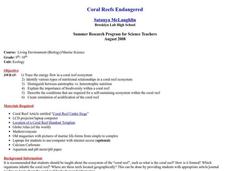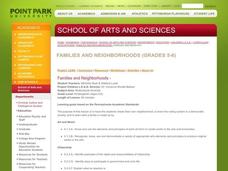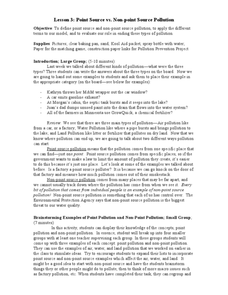Curated OER
Coral Reefs Endangered
Learners identify different types of nutritional relationships in a coral reef system and trace the energy flow. In this marine biology lesson students create a simulation of acidification of the coral reef.
Curated OER
Taxes: Where Does Your Money Go?
Young scholars explore the concept of taxes. In this tax lesson, students investigate types of taxes and deductions taken out of a paycheck before they see it. Young scholars calculate the tax on a given dollar amount. Students...
Curated OER
Eastern Woodland Indians
Fifth graders research the Eastern Woodland Indians in this lesson. They list the tribes and write a description of the physical environment. They list examples of the types of food, clothing, transportation, home/shelter,...
Curated OER
Peer Pressure
Sixth graders make estimations, calculations, and to collaborate with other students to solve a problem. It also teaches valuable refusal skills to combat negative peer pressure and provides students an opportunity to role play. ...
Curated OER
Angle Land and Angle Aerobics
Sixth graders investigate different types of angles. In this geometry instructional activity, 6th graders use a protractor to identify acute, obtuse, and straight angles.
Curated OER
Families and Neighborhoods
Students build their own neighborhood. In this instructional activity on community, students are introduced to books about families and neighborhoods. As a class, the students create their own neighborhood, elect a leader for their...
Curated OER
Human Rights in the Philippines
Students examine the meaning of human rights under the United Nations system, in the U.S., and the Philippines. They conduct research, discuss the concepts in groups, and conduct a debate on the human rights situation post Marcos...
Curated OER
Abraham Lincoln
Students brainstorm different names of presidents and reflect upon the importance of the role in government. They demonstrate a knowledge of the important events in the life of Abraham Lincoln. Students conduct research into the founding...
Curated OER
Justice in America
Eleventh graders analyze primary sources for evidence of intent and purpose. In this American government lesson, 11th graders compose a one-page response explaining their understanding of "justice." Students read and examine quotes about...
Curated OER
Early Colonial Labor Force: Indentured Servants and Slaves
Students study the labor force used during Colonial America. In this Colonial America lesson, students discuss labor types used in the colonies. Students read about indentured servants and the use of African slaves. Students use the...
Curated OER
Comparing World Religions
Sixth graders participate in a lesson of comparing the religions of the world. They conduct research using the essential questions provided in the lesson. There is a rubric for the writing assignment for assessment.
Curated OER
It's All About Power
Learners explore the legislative process by discussing a current issue dealing with energy policy. They explain the role of government and how it affects their quality of life. Students identify and list the groups that create energy...
Curated OER
Sexism: From Identification to Activism
Students explore the concept of sexism. In this tolerance activity, students recognize the attributes of sexism and discuss how they can combat it in their own lives.
Curated OER
The Need for Laws
Students consider the presence of authority in their lives. In this law lesson plan, students compare forgotten laws that function in their lives to forgotten instructions in making a peanut butter and jelly sandwich.
Curated OER
Philanthropy and You
Learners identify human rights and study the values of historical figures who fought for human rights. In this human rights lesson, students define the term human rights and research examples of human mistreatment in history. Learners...
Curated OER
Democracy Then and Now
Young scholars research more about the Canadian parliamentary democratic system.
Curated OER
Economics Study Guide
In this economics worksheet, students answer a variety of fill in and short answer questions, draw a diagram to illustrate the circular flow of economic activity, and write short essays to address prompts.
Curated OER
How Did That Get There?
Students evaluate the role of government in addressing land use and other environmental issues. They analyze the powers, responsibilities, and limitations of elected and appointed officials in the national legislative, executive, and...
Curated OER
Children's Literature
Introduce the students to basic economic concepts and types of economic systems and develop the an understanding of how economic choices involve costs and consequences; provide introduction to rural America circa 1920 and compare to our...
Curated OER
Ancient Highways-Native Byways of Salmon Lake State Park
Eighth graders investigate the concept of the trail system used by the Native Americans. They compare and contrast the trails to modern transportation roadways of today. Students also define the types of information archaeologists use to...
Curated OER
Explora-Pond: 1st Grade Shore Count
First graders experience addition through the exploration of a virtual pond. They categorize the various plants around the pond, count the number of various types of plants on the pond shore, and calculate the number of shrubs.
Curated OER
Point Source vs. Non-point Source Pollution
Young scholars define and differentiate between point source and non-point source pollution. Students discuss various types of pollution including air, water and land pollution, analyze demonstrations and complete a worksheet.
Curated OER
What It Is, What It Isn't
Third graders classify and sort different types of beans to be introduced to the classification system in science. As a class, they identify the characteristics of living and non-living organisms and make a chart in their journal to ...
Curated OER
What does it mean to be a citizen?
Students examine democracy and the role of a citizen. They contrast rights and responsibilities of individuals, groups, and organizations. Students identify two forms of democratic action and describe demoncratic values. Students observe...

























